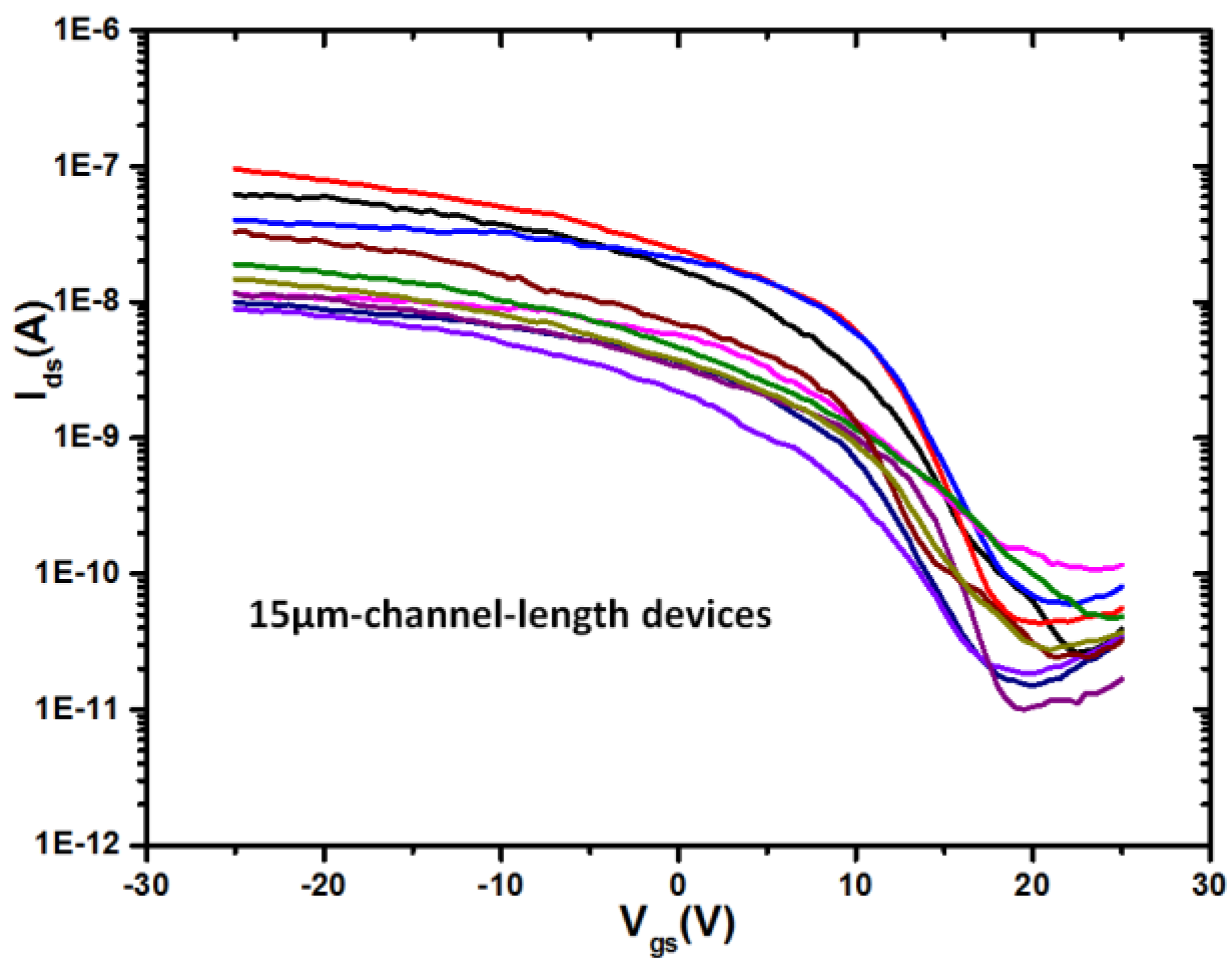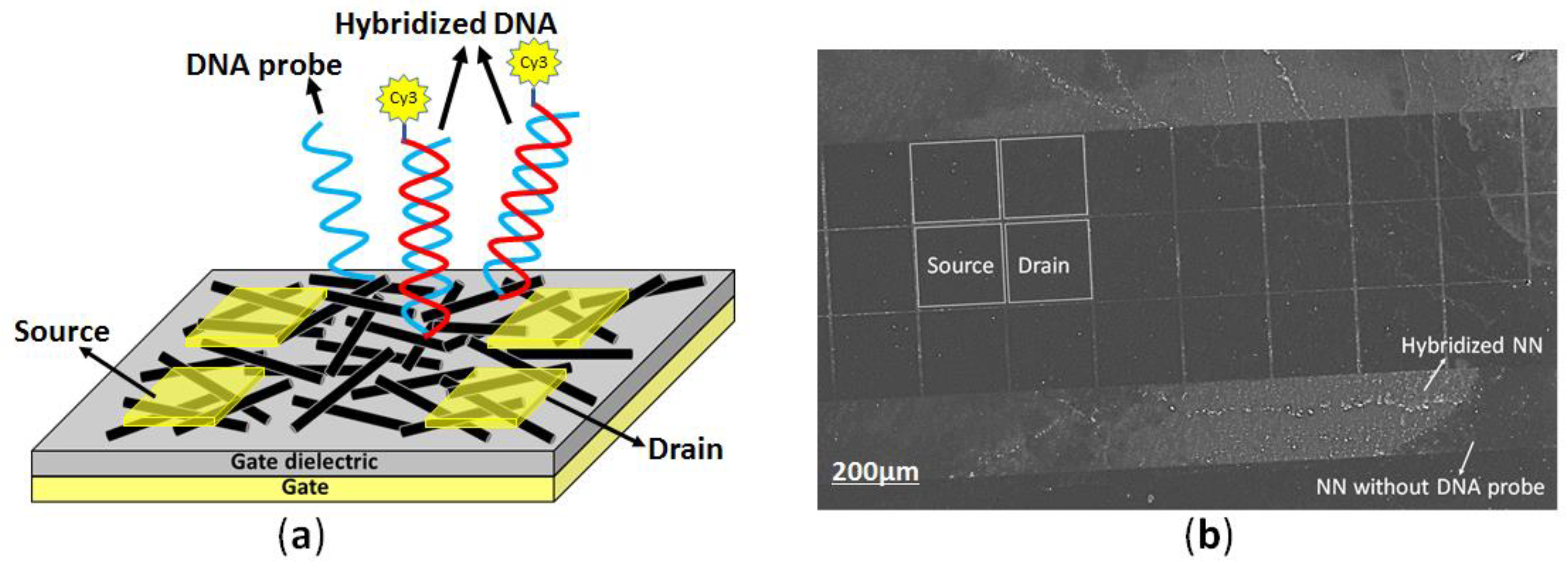On the Development of Label-Free DNA Sensor Using Silicon Nanonet Field-Effect Transistors †
Abstract
:1. Introduction
2. Results and Discussion
2.1. From Nanonet Formation to Functional NN-Based Field-Effect Transistors (FET)
2.2. Electrical Characterization of SiNN FETs before Functionalization
2.3. Functionalization Process of NN-Based Device for DNA Detection
2.4. Electrical Characterization of SiNN-Based DNA Sensor
3. Conclusions
Acknowledgments
Conflicts of Interest
References
- Noor, M.O.; Krull, U.J. Silicon nanowires as field-effect transducers for biosensor development: A review. Anal. Chim. Acta 2014, 825, 1–25. [Google Scholar] [CrossRef] [PubMed]
- Ternon, C. Serre, P.; Lebrun, J.M.; Brouzet, V.; Legallais, M.; David, S.; Missiaen, J.M. Low Temperature Processing to Form Oxidation Insensitive Electrical Contact at Silicon Nanowire/Nanowire Junctions. Adv. Electron. Mater. 2015, 1, 10. [Google Scholar]
- Ternon, C.; Serre, P.; Rey, G.; Holtzinger, C.; Periwal, P.; Martin, M.; Langlet, M. High aspect ratio semiconducting nanostructure random networks: Highly versatile materials for multiple applications. Phys. Status Solidi Rapid Res. Lett. 2013, 7, 919–923. [Google Scholar] [CrossRef]
- Serre, P.; Ternon, C.; Stambouli, V.; Periwal, P.; Baron, T. Fabrication of silicon nanowire networks for biological sensing. Sens. Actuators B Chem. 2013, 182, 390–395. [Google Scholar] [CrossRef]
- Serre, P.; Stambouli, V.; Weidenhaupt, M.; Baron, T.; Ternon, C. Silicon nanonets for biological sensing applications with enhanced optical detection ability. Biosens. Bioelectron. 2015, 68, 336–342. [Google Scholar] [CrossRef] [PubMed]
- Demes-Causse, T.; Morisot, F.; Legallais, M.; Calais, A.; Pernot, E.; Pignot-Paintrand, I.; Ternon, C.; Stambouli, V. DNA grafting on silicon nanonets using an eco-friendly functionalization process based on epoxy silane. Materials Today Proceedings 2018. to be published. [Google Scholar]
- Legallais, M.; Nguyen, T.T.T.; Mouis, M.; Salem, B.; Ternon, C. Toward the integration of Si nanonets into FETs for biosensing applications. In Proceedings of the 2017 Joint International EUROSOI Workshop and International Conference on Ultimate Integration on Silicon (EUROSOI-ULIS), Athens, Greece, 3–5 April 2017. [Google Scholar]
- Cazimajou, T.; Legallais, M.; Mouis, M.; Ternon, C.; Salem, B.; Ghibaudo, G. Electrical Characterization of Percolating Silicon Nanonet FETs for sensing applications. In Proceedings of the 2017 Joint International EUROSOI Workshop and International Conference on Ultimate Integration on Silicon (EUROSOI-ULIS), Athens, Greece, 3–5 April 2017. [Google Scholar]




© 2017 by the authors. Licensee MDPI, Basel, Switzerland. This article is an open access article distributed under the terms and conditions of the Creative Commons Attribution (CC BY) license (http://creativecommons.org/licenses/by/4.0/).
Share and Cite
Nguyen, T.T.T.; Legallais, M.; Morisot, F.; Cazimajou, T.; Mouis, M.; Salem, B.; Stambouli, V.; Ternon, C. On the Development of Label-Free DNA Sensor Using Silicon Nanonet Field-Effect Transistors. Proceedings 2017, 1, 312. https://doi.org/10.3390/proceedings1040312
Nguyen TTT, Legallais M, Morisot F, Cazimajou T, Mouis M, Salem B, Stambouli V, Ternon C. On the Development of Label-Free DNA Sensor Using Silicon Nanonet Field-Effect Transistors. Proceedings. 2017; 1(4):312. https://doi.org/10.3390/proceedings1040312
Chicago/Turabian StyleNguyen, Thi Thu Thuy, Maxime Legallais, Fanny Morisot, Thibauld Cazimajou, Mireille Mouis, Bassem Salem, Valérie Stambouli, and Céline Ternon. 2017. "On the Development of Label-Free DNA Sensor Using Silicon Nanonet Field-Effect Transistors" Proceedings 1, no. 4: 312. https://doi.org/10.3390/proceedings1040312




